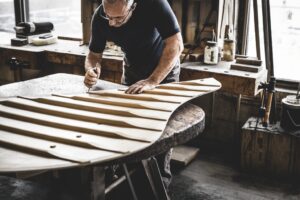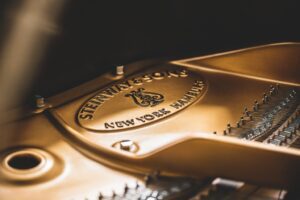A review of Steinway’s Model S: The baby grand
October 8, 2021 •Stephen Reed
So you’d like to experience the “Steinway sound” but don’t think you have an adequate space for a grand piano in your home. What to do? You could compromise and get a nice upright instead, but what if you feel unfulfilled--and after spending thousands of dollars?

Baby grands may not have the full power of a full grand piano. However, they are beloved for their unique capacity to bring the essential experience of a grand piano into much smaller spaces in a home or small venue.
The Steinway Model S is a well-conceived piano that conveys the famous Steinway sound despite its small scale design. At 5’1” (155 cm), the Model S is the smallest of the Steinway grands. The first ones were made in mahogany.
We’ll take a look in this article at the Model S’s history, scale design, soundboard, and action, demonstrating why it can be the perfect fit for a buyer who wants the Steinway experience in a smaller package.
Depression-era rollout
-
According to M. Steinert & Sons President Emeritus Paul Murphy, to compete with smaller and less expensive pianos built by Steinway’s competition, the S was introduced in 1936 at $885.
 Steinway's Model S was part of Steinway's Depression-era strategy to offer reasonably-priced grand pianos.
Steinway's Model S was part of Steinway's Depression-era strategy to offer reasonably-priced grand pianos. - Murphy notes that this amount was lower than Steinway’s Model M at the time, which was priced at about $1,250.
During the difficult days of the Great Depression, some believe the less expensive Model S was key to keeping Steinway & Sons afloat.
Small scale design
To accommodate a significant section of the piano market requiring either a smaller piano in terms of size, price, or both, piano engineers at Steinway & Sons had to tackle the issue of small scale design.
Low bass register issues in baby grands
Strings in the low bass register are among the longest in a piano. In light of the lost length due to the smaller piano size, bass strings are wrapped in copper and made thicker.
This additional density makes the bass strings stiffer, which can lead to “inharmonicity.” That is when a string’s harmonics deviate from their natural frequencies. The challenge for piano engineers is to avoid having the ear hear an indistinct pitch.
In addition, bass register strings must have soundboard flexibility. Otherwise, the bass tone in baby grand pianos can sound dull with limited sustain.
In six years, the Model S’s scale comes a long way
According to Paul Murphy, Steinway took about six years to develop what is now the Model S scale. In the late 1930s, most scale designs had to be built into pianos to prove themselves.
The Model S’s scale had to wait six years because Steinway & Sons insisted that it have the “Steinway sound” like the other, larger Steinway grands.
-
Today, piano scales can be designed with computers, which is how the Boston and Essex scales have been designed. This modern technology allowed Steinway to design a full line of pianos before they built the first one.
 The Model S’s Diaphragmatic Soundboard--the best ever made
The Model S’s Diaphragmatic Soundboard--the best ever made
Steinway’s enormous amount of work in building the Diaphragmatic Soundboard--seen as the best soundboard ever made--helps to avoid such bass register problems. This patented soundboard was one of the distinctive features of the Model S.
This new soundboard was tapered around the edges where it meets the rim by about the thickness of a kitchen match.
This allowed the board to vibrate more freely and project sound longer than the uniform thickness board which was the prior design. In fact, the Model S, with the new soundboard, projected tone better than the Model M (5’7”).
The Diaphragmatic Soundboard was so successful that it was ultimately used in all Steinway models as it is today.
The action of the baby grand
True, in shorter grand pianos, there is a discernible difference in touch weight when playing at the front of the key, as well as the place immediately next to the fallboard. As a result, the keyboard may not respond as well to sensitive touch as with longer pianos.
However, Steinway managed to install the same key length in its grands all the way up to the Model A at 6’2” feet in length. This gives the Model S a distinct advantage over many of its competitors.
The Model S shares the same exact materials and handcrafted workmanship as the Steinway flagship concert grand, the Model D. The only difference is size.
Model S’s action’s touch response is excellent, with a skilled pianist having no problem with techniques like legato and staccato. For a smaller piano, the Model S’s range of volume is impressive, as well.
The Steinway Model S’s ideal owner
Steinway’s Model S is not for everyone. A professional concert pianist will want to have a Model B or D, which will allow them a wider dynamic range due to their larger size.
However, if you want the Steinway sound but have real space considerations, the Model S can be the perfect fit for their home or small venue. The S is a special order piano from Steinway, only a little smaller than the Model M.
Cost of the Steinway Model S
The least expensive of the Steinway grand pianos, the Model S’s 2023 price is $86,600 with an ebony finish.
-
The Steinway Model S has always had devoted fans
 Despite the Model S’s small size, from its beginnings the S has had its backers. When the Model S pianos were rolled out in 1936, no less a performer than Steinway Immortal Josef Hoffman went public with his appreciation for this new baby grand.
Despite the Model S’s small size, from its beginnings the S has had its backers. When the Model S pianos were rolled out in 1936, no less a performer than Steinway Immortal Josef Hoffman went public with his appreciation for this new baby grand.
Hoffman was so impressed by the Model S that he bought 50 of them for the Curtis Institute.
Today, you’ll hear Model S owners coo over their “little Steinway.” The reason is clear: the Model S has allowed them to enjoy the Steinway sound despite their more modest home size or lower budget. Without the S, they simply would not have that daily experience in their home.
Come in and learn more about the Model S from one of M. Steinert & Son’s professional piano consultants. Meantime, read more about Steinway grands from these articles:
- Will a grand piano fit? M. Steinert & Son’s Patrick Elisha demonstrates how a baby grand piano can occupy a similar space to a vertical-style piano.
- New vs. Used Steinway
- A review of the Steinway Model M: Is the M the right piano for me?
Featured Articles
Categories
- Beginner Pianos (23)
- Boston Pianos (15)
- Comparisons (30)
- Designer and Specialty Pianos (8)
- Essex Pianos (10)
- Events (11)
- Featured (24)
- Institutional (3)
- Joy of Piano (15)
- Learning About Pianos (69)
- News (35)
- Pricing and Cost (19)
- Resource Center (122)
- Roland Pianos (6)
- Spirio (15)
- Steinway Pianos (70)
- Student (14)
- Teacher (13)
- Used Pianos (20)
- Videos (19)

